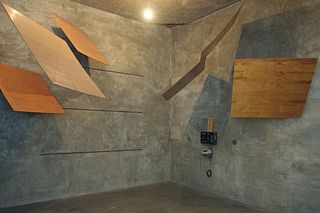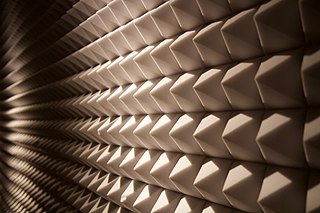Related Research Articles

Scattering is a term used in physics to describe a wide range of physical processes where moving particles or radiation of some form, such as light or sound, are forced to deviate from a straight trajectory by localized non-uniformities in the medium through which they pass. In conventional use, this also includes deviation of reflected radiation from the angle predicted by the law of reflection. Reflections of radiation that undergo scattering are often called diffuse reflections and unscattered reflections are called specular (mirror-like) reflections. Originally, the term was confined to light scattering. As more "ray"-like phenomena were discovered, the idea of scattering was extended to them, so that William Herschel could refer to the scattering of "heat rays" in 1800. John Tyndall, a pioneer in light scattering research, noted the connection between light scattering and acoustic scattering in the 1870s. Near the end of the 19th century, the scattering of cathode rays and X-rays was observed and discussed. With the discovery of subatomic particles and the development of quantum theory in the 20th century, the sense of the term became broader as it was recognized that the same mathematical frameworks used in light scattering could be applied to many other phenomena.
Reverberation, in acoustics, is a persistence of sound after it is produced. Reverberation is created when a sound or signal is reflected. This causes numerous reflections to build up and then decay as the sound is absorbed by the surfaces of objects in the space – which could include furniture, people, and air. This is most noticeable when the sound source stops but the reflections continue, their amplitude decreasing, until zero is reached.
Room acoustics is a subfield of acoustics dealing with the behaviour of sound in enclosed or partially-enclosed spaces. The architectural details of a room influences the behaviour of sound waves within it, with the effects varying by frequency. Acoustic reflection, diffraction, and diffusion can combine to create audible phenomena such as room modes and standing waves at specific frequencies and locations, echos, and unique reverberation patterns.

An echo chamber is a hollow enclosure used to produce reverberation, usually for recording purposes. For example, the producers of a television or radio program might wish to produce the aural illusion that a conversation is taking place in a large room or a cave; these effects can be accomplished by playing the recording of the conversation inside an echo chamber, with an accompanying microphone to catch the reverberation. Nowadays, effects units are more widely used to create such effects, but echo chambers are still used today, such as the famous echo chambers at Capitol Studios.

An anechoic chamber is a room designed to stop reflections or echoes of either sound or electromagnetic waves. They are also often isolated from energy entering from their surroundings. This combination means that a person or detector exclusively hears direct sounds, in effect simulating being outside in a free field.

Soundproofing is any means of impeding sound propagation. There are several basic ways to reduce sound: increasing the distance between source and receiver, decoupling, using noise barriers to reflect or absorb the energy of the sound waves, using damping structures such as sound baffles for absorption, or using active antinoise sound generators.

Reflection is the change in direction of a wavefront at an interface between two different media so that the wavefront returns into the medium from which it originated. Common examples include the reflection of light, sound and water waves. The law of reflection says that for specular reflection the angle at which the wave is incident on the surface equals the angle at which it is reflected.

Specular reflection, or regular reflection, is the mirror-like reflection of waves, such as light, from a surface.

The noise reduction coefficient is a single number value ranging from 0.0 to 1.0 that describes the average sound absorption performance of a material. An NRC of 0.0 indicates the object does not attenuate mid-frequency sounds, but rather reflects sound energy. This is more conceptual than physically achievable: even very thick concrete walls will attenuate sound and may have an NRC of 0.05. Conversely, an NRC of 1.0 indicates that the material provides an acoustic surface area that is equivalent to its physical, two-dimensional surface area. This rating is common of thicker, porous sound absorptive materials such as 2"-thick fabric-wrapped fiberglass panel. Materials can achieve NRC values greater than 1.00. This is a shortcoming of the test procedure and a limitation of how acousticians define a square unit of absorption, and not a characteristic of the material itself.

Architectural acoustics is the science and engineering of achieving a good sound within a building and is a branch of acoustical engineering. The first application of modern scientific methods to architectural acoustics was carried out by the American physicist Wallace Sabine in the Fogg Museum lecture room. He applied his newfound knowledge to the design of Symphony Hall, Boston.
Sound Transmission Class is an integer rating of how well a building partition attenuates airborne sound. In the US, it is widely used to rate interior partitions, ceilings, floors, doors, windows and exterior wall configurations. Outside the US, the ISO Sound Reduction Index (SRI) is used. The STC rating very roughly reflects the decibel reduction of noise that a partition can provide. The STC is useful for evaluating annoyance due to speech sounds, but not music or machinery noise as these sources contain more low frequency energy than speech.
Critical distance is, in acoustics, the distance at which the sound pressure level of the direct sound D and the reverberant sound R are equal when dealing with a directional source. As the source is directional, the sound pressure as a function of distance between source and sampling point (listener) varies with their relative position, so that for a particular room and source the set of points where direct and reverberant sound pressure are equal constitutes a surface rather than a distinguished location in the room. In other words, it is the point in space at which the combined amplitude of all the reflected echoes are the same as the amplitude of the sound coming directly from the source. This distance, called the critical distance , is dependent on the geometry and absorption of the space in which the sound waves propagate, as well as the dimensions and shape of the sound source.
In a reverberant space, the sound perceived by a listener is a combination of direct and reverberant sound. The ratio of direct sound is dependent on the distance between the source and the listener, and upon the reverberation time in [the room]. At a certain distance the two will be equal. This is called the "critical distance."

In acoustics, absorption refers to the process by which a material, structure, or object takes in sound energy when sound waves are encountered, as opposed to reflecting the energy. Part of the absorbed energy is transformed into heat and part is transmitted through the absorbing body. The energy transformed into heat is said to have been 'lost'.

Acoustic foam is an open celled foam used for acoustic treatment. It attenuates airbone sound waves, reducing their amplitude, for the purposes of noise reduction or noise control. The energy is dissipated as heat. Acoustic foam can be made in several different colors, sizes and thickness.

Loudspeaker measurement is the practice of determining the behaviour of loudspeakers by measuring various aspects of performance. This measurement is especially important because loudspeakers, being transducers, have a higher level of distortion than other audio system components used in playback or sound reinforcement.

Diffusion, in architectural acoustics, is the spreading of sound energy evenly in a given environment. A perfectly diffusive sound space is one in which the reverberation time is the same at any listening position. Most interior spaces are non-diffusive; the reverberation time is considerably different around the room. At low frequencies, they suffer from prominent resonances called room modes.
The sound reduction index is used to measure the level of sound insulation provided by a structure such as a wall, window, door, or ventilator. It is defined in the series of international standards ISO 16283 and the older ISO 140, or the regional or national variants on these standards. In the United States, the sound transmission class rating is generally used instead. The basic method for both the actual measurements and the mathematical calculations behind both standards is similar, however they diverge to a significant degree in the detail, and in the numerical results produced.
Noise, vibration, and harshness (NVH), also known as noise and vibration (N&V), is the study and modification of the noise and vibration characteristics of vehicles, particularly cars and trucks. While noise and vibration can be readily measured, harshness is a subjective quality, and is measured either via jury evaluations, or with analytical tools that can provide results reflecting human subjective impressions. The latter tools belong to the field psychoacoustics.

Underwater acoustics is the study of the propagation of sound in water and the interaction of the mechanical waves that constitute sound with the water, its contents and its boundaries. The water may be in the ocean, a lake, a river or a tank. Typical frequencies associated with underwater acoustics are between 10 Hz and 1 MHz. The propagation of sound in the ocean at frequencies lower than 10 Hz is usually not possible without penetrating deep into the seabed, whereas frequencies above 1 MHz are rarely used because they are absorbed very quickly.
Diffuse field acoustic testing is the testing of the mechanical resistance of a spacecraft to the acoustic pressures during launch.